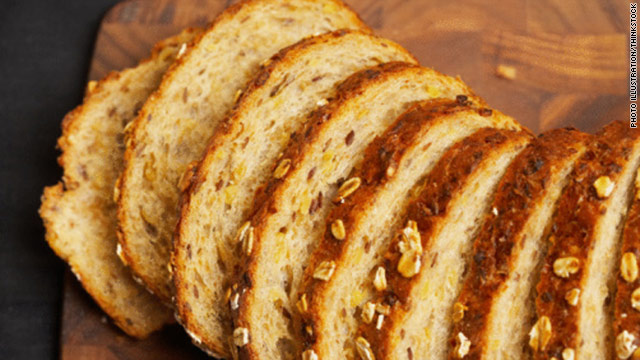At a minimum, half of all grains we eat should be whole grains,
but most people don't meet this goal.
(Parenting.com) -- Pediatrician Dr. Alan Greene, M.D., recommends simple, everyday replacements for what you're eating, doing and even breathing that can have a major impact on your kids' health. I remember my delight at discovering the Control-H command in Microsoft Word. I know it's a small discovery, but with a few simple keystrokes, I could find and replace any string of text in a long document.
I can only imagine how much time that handy trick has saved me over the years. Wouldn't it be great to be able to do that in real life? And imagine if it wasn't time we were saving, but our family's health?
I'm always on the lookout for smart substitutions for parents, where simply replacing one thing with another can make life better, healthier, or safer. I've highlighted my top substitutions for you. With an imaginary Ctrl-H, look for these items in your home -- whether in a medicine cabinet, kitchen, or child's bedroom -- and consider upgrading.
IN: Honey
OUT: DM cough medicine
Parents spend billions on over-the-counter cough remedies, even though the American Academy of Pediatrics never recommends them for kids under age 2, and cautions against their use under age 6. Is it worth it?
Researchers have done a head-to-head comparison of dextromethorphan (the cough suppressant found in "DM" cold medications) with a less expensive natural remedy: honey. The honey outperformed DM in every category, from reducing the number and severity of coughs, to improving sleep--for kids and parents.
The most effective honeys appear to be the darker varieties. The suggested dose for ages 1 to 6 is one-half teaspoon 30 minutes before bed, increasing to one teaspoon for children 6 to 11 years old.
Dark chocolate contains a different ingredient that has tested better than DM for coughs. I use a half ounce of dark chocolate under age 6, and one ounce from 6 to 11. The effect lasts about four hours.
IN: Whole grains
OUT: Refined grains
Refined grains and whole grains may seem similar, but they are quite different. Whole grains are more than just starch, containing up to 25% of other goodies, including protein, fiber, and added healthy omega-3's, along with a complex mixture of vitamins, minerals, and other micronutrients. The refining process strips away much of what is best about grains and can leave a white product that may be up to 94% starch. This makeover changes the way grains are absorbed and used by the body and the effect they have on blood sugar, even though a few simple vitamins and iron are added back.
At a minimum, half of all grains we eat should be whole grains. Less than 5% of Americans are meeting this modest goal, according to the USDA. Start with starches. When it comes to pasta, sandwich breads, bagels, dinner rolls, or hamburger buns, opt for whole grain.
IN: Oils
OUT: Solid fats
Solid fats are often one of the biggest sources of empty calories in kids' diets. Both saturated fats and trans fats, hidden in many processed foods, tend to be solid at room temperature. Getting too much solid fat in the diet has been linked to chronic disease, especially diseases of the heart and blood vessels.
The biggest source of solid fats in kids' diets is what's used in baked goods. Luckily, using olive oil as a substitute can give results sinfully similar to the original. In one study, researchers made three types of cakes: margarine only, extra-virgin olive oil only, and a combination of olive oil and margarine. The tasters found that all three cakes had the same aroma and tasted remarkably similar. In fact, the reduced-trans-fat cake actually edged out the margarine cake as the winner.
Even if you're not a confectioner, there are plenty of ways to make this change at home. My family adopted this substitution: a bowl of olive oil with a splash of balsamic vinegar for dipping bread or veggies. Replacing conventional beef with turkey, chicken, seafood, or beans is another way to Ctrl-H solid fats.
IN: Houseplants
OUT: Air fresheners
Indoor air can be up to 10 times as polluted as outdoor air, triggering health problems such as asthma. What we call "air fresheners" may freshen the smell, but they just mask the pollution--and may even act as irritants themselves.
Certain houseplants can truly freshen the air, removing up to 90% of the toxins from a room. In an effort to identify plants that can filter air in sealed environments, NASA and the Associated Landscape Contractors of America tested common plants to determine the best natural filters. Among the winners? Mums, gerbera daisies, and the peace lily, which is a favorite of mine because it looks good and even I can keep one alive.
IN: An hour outdoors
OUT: An hour indoors
Indoors is associated not only with television and video games but also with inactivity, restlessness, and low energy. By contrast, outdoors is associated not only with sports and nature but also with movement, activity, and high energy.
Still, it's about more than working up a good sweat. Being outside also engages our children's minds and triggers imagination and creativity. It's great for kids to spend time disconnected from a steady stream of passive entertainment. Spending time outdoors has also been linked to improved mood, behavior, and attention.
Outdoor play can provide vitamin D, too, which is linked not just to bone health but to reduced asthma symptoms, eczema severity, and diabetes. Many kids aren't getting enough from their diet or the sun, especially since sunscreen can block vitamin D formation as well as blocking harmful rays, so take 'em outside!
IN: Flavored water
OUT: Sugary drinks
When you talk about kids eating too much sugar, the usual suspects come to mind: breakfast cereals, sweet snacks, desserts, and candy. But, in fact, the largest source of added sugars in our kids' diets is what they drink.
Whether we're talking sodas, sports drinks, or juice drinks, beverages are a leading source of both extra calories and extra sugars. This is no small deal! Too much sugar leads not only to ballooning weight and waist size but perhaps also to worsening blood pressure, cholesterol, and blood sugar--even type 2 diabetes.
Revisiting what our kids drink is a great place to start. We do this in our home by keeping a big jar with a spigot on our kitchen counter. It's filled with ice water that's been flavored with fruits, veggies, or herbs: mint, orange, lemon basil, ginger, and cucumber. Tasty and always available, it helps keep the whole family hydrated and healthy.
IN: Real food for baby
OUT: White-rice baby cereal
This could be the single most important change to tilt the trajectory of kids' taste preferences. We've learned in the 21st century that early food experiences play a key role both in forming lasting taste preferences and in pre-setting metabolisms. On average, if babies taste a food six to ten times, they are more likely to develop a fondness for it. Foods for babies should be things we want them to like down the road.
For decades, most babies have been given processed white-rice flour (called rice cereal) dozens of times, often before they get any other experience with food. It became the top source of food calories throughout the first year. This white starch starts to turn to sugar before it leaves a baby's mouth, and it is straight glucose by the time it's absorbed. It's no wonder that refined-flour sweets are often the biggest source of calories for the rest of childhood.
Brown-rice cereal is an easy substitution. I also love banana as a first food, fork-mashed with some breast milk or formula.
IN: Grass-fed organic beef
OUT: Conventional beef
Side by side, two cuts of meat may look almost identical, but they can come from cows raised in very different ways. I've been to the crowded, fenced-in feedlots where cattle are fed cattle-junk food to fatten them up. I've also stood on expansive green hillsides under the open blue sky and strolled among cattle grazing on old-fashioned pasture. If we are what we eat, then we are what our food animals eat, too.
Grass-fed cattle are raised on pasture without the use of synthetic hormones, toxic pesticides, genetic modification, cloning, or antibiotics. The meat can have up to four times the healthy omega-3 fats of feedlot beef. Ask questions at the meat counter; read labels.





